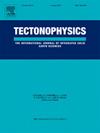Moho depth variations of Zealandia from gravity data inversion and implications for continental breakup
IF 2.7
3区 地球科学
Q2 GEOCHEMISTRY & GEOPHYSICS
引用次数: 0
Abstract
The thickness of the Earth's crust, along with the relief and characteristics of the Moho discontinuity, serves as a critical constraint for numerous geoscientific investigations. By removing the gravitational effects of topography, seawater, sediment, and thermo-gravitational effects from the lithosphere in Zealandia and its adjacent regions, we isolate the gravity anomaly associated with the Moho discontinuity to compute its depth. We determined the intercept of the linear relationship between Moho depth derived from the global crust model CRUST1.0 and corresponding Moho gravity anomalies as an estimate for mean Moho depth. A laterally variable crust-mantle density contrast was initially obtained using Bouguer plate formula based on both CRUST1.0-derived Moho depths and observed gravity anomalies; this was subsequently rescaled utilizing the slope of linear regression between actual Moho gravity anomalies and fitted gravity anomalies computed from CRUST1.0-derived Moho depths alongside our initial density contrast estimates. The results calculated via Parker-Oldenburg formula indicate that Zealandia's Moho depth primarily ranges from 8 to 28 km, while crustal thickness varies between 4 and 26 km. These values are significantly greater than those typical of oceanic crust but remain less than those characteristic of continental crust. Within our study area, identified ocean basins show a decreasing trend in crustal thickness relative to both oceanic crust age and increasing water depth. When considering only areas where crustal thickness is less than 16 km on scatter plots, Middleton Basin and Lord Howe Basin display substantially greater thicknesses compared to New Caledonia Basin and Fairway Basin. This observation suggests that if these four basins possess oceanic crusts beneath them, then it is likely that the oceanic crust underlying Middleton and Lord Howe Basins predates that found beneath New Caledonia and Fairway Basins, implying that post-Zealandia separation from Gondwana involved rifting predominantly linked to subduction rollback of the Pacific Plate.
重力资料反演的西兰迪亚莫霍深度变化及其对大陆分裂的启示
地壳的厚度,以及莫霍不连续性的起伏和特征,是许多地球科学调查的关键限制因素。通过消除地形、海水、沉积物和热重力对西兰迪亚及其邻近地区岩石圈的重力影响,我们分离出与莫霍不连续相关的重力异常,并计算其深度。我们确定了由全球地壳模型甲壳1.0得到的莫霍深度与相应的莫霍重力异常之间的线性关系的截距,作为平均莫霍深度的估计。基于甲壳1.0反演的莫霍深度和观测到的重力异常,利用布格板块公式初步获得了横向变壳幔密度对比;随后,利用实际Moho重力异常与由甲壳1.0导出的Moho深度计算的拟合重力异常之间的线性回归斜率,以及我们的初始密度对比估计,对其进行了重新缩放。根据Parker-Oldenburg公式计算结果表明,西兰迪亚的莫霍深度主要在8 ~ 28 km之间,地壳厚度主要在4 ~ 26 km之间。这些值明显大于洋壳的特征值,但仍小于大陆壳的特征值。在研究区内,已确定的洋盆地壳厚度随洋壳年龄和水深的增加均呈减小趋势。当只考虑散点图上地壳厚度小于16公里的地区时,米德尔顿盆地和Lord Howe盆地的厚度比新喀里多尼亚盆地和Fairway盆地大得多。这一观察结果表明,如果这四个盆地下面有海洋地壳,那么米德尔顿盆地和豪勋爵盆地下面的海洋地壳很可能早于新喀里多尼亚盆地和费尔韦盆地下面的海洋地壳,这意味着西兰迪亚与冈瓦纳大陆分离后的裂谷作用主要与太平洋板块的俯冲回滚有关。
本文章由计算机程序翻译,如有差异,请以英文原文为准。
求助全文
约1分钟内获得全文
求助全文
来源期刊

Tectonophysics
地学-地球化学与地球物理
CiteScore
4.90
自引率
6.90%
发文量
300
审稿时长
6 months
期刊介绍:
The prime focus of Tectonophysics will be high-impact original research and reviews in the fields of kinematics, structure, composition, and dynamics of the solid arth at all scales. Tectonophysics particularly encourages submission of papers based on the integration of a multitude of geophysical, geological, geochemical, geodynamic, and geotectonic methods
 求助内容:
求助内容: 应助结果提醒方式:
应助结果提醒方式:


